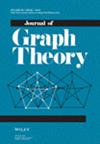求助PDF
{"title":"关于k边-哈密顿连通线图","authors":"Baoleer, Kenta Ozeki","doi":"10.1002/jgt.23252","DOIUrl":null,"url":null,"abstract":"<div>\n \n <p>We say that a graph <span></span><math>\n <semantics>\n <mrow>\n \n <mrow>\n <mi>G</mi>\n </mrow>\n </mrow>\n </semantics></math> is <span></span><math>\n <semantics>\n <mrow>\n \n <mrow>\n <mi>k</mi>\n </mrow>\n </mrow>\n </semantics></math><i>-edge-Hamilton-connected</i> if <span></span><math>\n <semantics>\n <mrow>\n \n <mrow>\n <mi>G</mi>\n \n <mo>+</mo>\n \n <mi>M</mi>\n </mrow>\n </mrow>\n </semantics></math> has a Hamilton cycle containing all edges of <span></span><math>\n <semantics>\n <mrow>\n \n <mrow>\n <mi>M</mi>\n </mrow>\n </mrow>\n </semantics></math> for any <span></span><math>\n <semantics>\n <mrow>\n \n <mrow>\n <mi>M</mi>\n \n <mo>⊆</mo>\n \n <mrow>\n <mo>{</mo>\n \n <mrow>\n <mi>x</mi>\n \n <mi>y</mi>\n \n <mo>∣</mo>\n \n <mi>x</mi>\n \n <mo>,</mo>\n \n <mi>y</mi>\n \n <mo>∈</mo>\n \n <mi>V</mi>\n \n <mrow>\n <mo>(</mo>\n \n <mi>G</mi>\n \n <mo>)</mo>\n </mrow>\n </mrow>\n \n <mo>}</mo>\n </mrow>\n </mrow>\n </mrow>\n </semantics></math> with <span></span><math>\n <semantics>\n <mrow>\n \n <mrow>\n <mo>∣</mo>\n \n <mi>M</mi>\n \n <mo>∣</mo>\n \n <mo>≤</mo>\n \n <mi>k</mi>\n </mrow>\n </mrow>\n </semantics></math> such that <span></span><math>\n <semantics>\n <mrow>\n \n <mrow>\n <mi>M</mi>\n </mrow>\n </mrow>\n </semantics></math> is a linear forest. In 2012, Kužel et al. conjectured that every 4-connected line graph is 2-edge-Hamilton-connected, and proved that it is equivalent to Thomassen's conjecture stating that every 4-connected line graph is Hamiltonian. In this paper, we prove that for <span></span><math>\n <semantics>\n <mrow>\n \n <mrow>\n <mi>k</mi>\n \n <mo>≥</mo>\n \n <mn>2</mn>\n </mrow>\n </mrow>\n </semantics></math> every <span></span><math>\n <semantics>\n <mrow>\n \n <mrow>\n <mrow>\n <mo>(</mo>\n \n <mrow>\n <mi>k</mi>\n \n <mo>+</mo>\n \n <mn>5</mn>\n </mrow>\n \n <mo>)</mo>\n </mrow>\n </mrow>\n </mrow>\n </semantics></math>-connected line graph is <span></span><math>\n <semantics>\n <mrow>\n \n <mrow>\n <mi>k</mi>\n </mrow>\n </mrow>\n </semantics></math>-edge-Hamilton-connected.</p>\n </div>","PeriodicalId":16014,"journal":{"name":"Journal of Graph Theory","volume":"110 1","pages":"92-100"},"PeriodicalIF":1.0000,"publicationDate":"2025-04-23","publicationTypes":"Journal Article","fieldsOfStudy":null,"isOpenAccess":false,"openAccessPdf":"","citationCount":"0","resultStr":"{\"title\":\"On \\n \\n \\n \\n k\\n \\n \\n -Edge-Hamilton-Connected Line Graphs\",\"authors\":\"Baoleer, Kenta Ozeki\",\"doi\":\"10.1002/jgt.23252\",\"DOIUrl\":null,\"url\":null,\"abstract\":\"<div>\\n \\n <p>We say that a graph <span></span><math>\\n <semantics>\\n <mrow>\\n \\n <mrow>\\n <mi>G</mi>\\n </mrow>\\n </mrow>\\n </semantics></math> is <span></span><math>\\n <semantics>\\n <mrow>\\n \\n <mrow>\\n <mi>k</mi>\\n </mrow>\\n </mrow>\\n </semantics></math><i>-edge-Hamilton-connected</i> if <span></span><math>\\n <semantics>\\n <mrow>\\n \\n <mrow>\\n <mi>G</mi>\\n \\n <mo>+</mo>\\n \\n <mi>M</mi>\\n </mrow>\\n </mrow>\\n </semantics></math> has a Hamilton cycle containing all edges of <span></span><math>\\n <semantics>\\n <mrow>\\n \\n <mrow>\\n <mi>M</mi>\\n </mrow>\\n </mrow>\\n </semantics></math> for any <span></span><math>\\n <semantics>\\n <mrow>\\n \\n <mrow>\\n <mi>M</mi>\\n \\n <mo>⊆</mo>\\n \\n <mrow>\\n <mo>{</mo>\\n \\n <mrow>\\n <mi>x</mi>\\n \\n <mi>y</mi>\\n \\n <mo>∣</mo>\\n \\n <mi>x</mi>\\n \\n <mo>,</mo>\\n \\n <mi>y</mi>\\n \\n <mo>∈</mo>\\n \\n <mi>V</mi>\\n \\n <mrow>\\n <mo>(</mo>\\n \\n <mi>G</mi>\\n \\n <mo>)</mo>\\n </mrow>\\n </mrow>\\n \\n <mo>}</mo>\\n </mrow>\\n </mrow>\\n </mrow>\\n </semantics></math> with <span></span><math>\\n <semantics>\\n <mrow>\\n \\n <mrow>\\n <mo>∣</mo>\\n \\n <mi>M</mi>\\n \\n <mo>∣</mo>\\n \\n <mo>≤</mo>\\n \\n <mi>k</mi>\\n </mrow>\\n </mrow>\\n </semantics></math> such that <span></span><math>\\n <semantics>\\n <mrow>\\n \\n <mrow>\\n <mi>M</mi>\\n </mrow>\\n </mrow>\\n </semantics></math> is a linear forest. In 2012, Kužel et al. conjectured that every 4-connected line graph is 2-edge-Hamilton-connected, and proved that it is equivalent to Thomassen's conjecture stating that every 4-connected line graph is Hamiltonian. In this paper, we prove that for <span></span><math>\\n <semantics>\\n <mrow>\\n \\n <mrow>\\n <mi>k</mi>\\n \\n <mo>≥</mo>\\n \\n <mn>2</mn>\\n </mrow>\\n </mrow>\\n </semantics></math> every <span></span><math>\\n <semantics>\\n <mrow>\\n \\n <mrow>\\n <mrow>\\n <mo>(</mo>\\n \\n <mrow>\\n <mi>k</mi>\\n \\n <mo>+</mo>\\n \\n <mn>5</mn>\\n </mrow>\\n \\n <mo>)</mo>\\n </mrow>\\n </mrow>\\n </mrow>\\n </semantics></math>-connected line graph is <span></span><math>\\n <semantics>\\n <mrow>\\n \\n <mrow>\\n <mi>k</mi>\\n </mrow>\\n </mrow>\\n </semantics></math>-edge-Hamilton-connected.</p>\\n </div>\",\"PeriodicalId\":16014,\"journal\":{\"name\":\"Journal of Graph Theory\",\"volume\":\"110 1\",\"pages\":\"92-100\"},\"PeriodicalIF\":1.0000,\"publicationDate\":\"2025-04-23\",\"publicationTypes\":\"Journal Article\",\"fieldsOfStudy\":null,\"isOpenAccess\":false,\"openAccessPdf\":\"\",\"citationCount\":\"0\",\"resultStr\":null,\"platform\":\"Semanticscholar\",\"paperid\":null,\"PeriodicalName\":\"Journal of Graph Theory\",\"FirstCategoryId\":\"100\",\"ListUrlMain\":\"https://onlinelibrary.wiley.com/doi/10.1002/jgt.23252\",\"RegionNum\":3,\"RegionCategory\":\"数学\",\"ArticlePicture\":[],\"TitleCN\":null,\"AbstractTextCN\":null,\"PMCID\":null,\"EPubDate\":\"\",\"PubModel\":\"\",\"JCR\":\"Q2\",\"JCRName\":\"MATHEMATICS\",\"Score\":null,\"Total\":0}","platform":"Semanticscholar","paperid":null,"PeriodicalName":"Journal of Graph Theory","FirstCategoryId":"100","ListUrlMain":"https://onlinelibrary.wiley.com/doi/10.1002/jgt.23252","RegionNum":3,"RegionCategory":"数学","ArticlePicture":[],"TitleCN":null,"AbstractTextCN":null,"PMCID":null,"EPubDate":"","PubModel":"","JCR":"Q2","JCRName":"MATHEMATICS","Score":null,"Total":0}
引用次数: 0
引用
批量引用

 求助内容:
求助内容: 应助结果提醒方式:
应助结果提醒方式:


